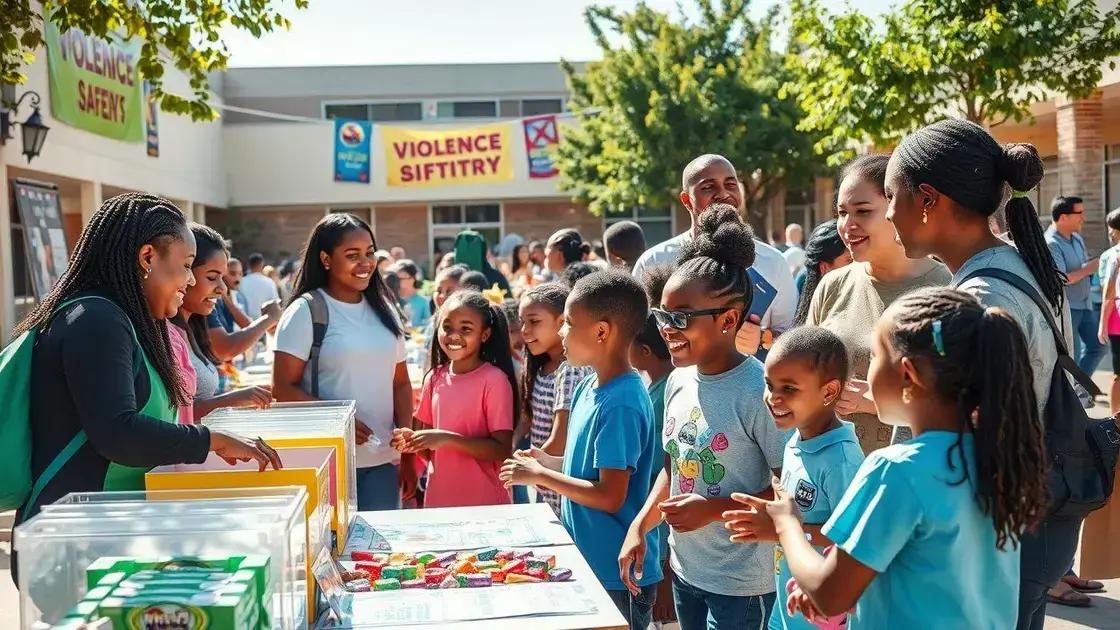Funding for school violence prevention programs: what you need to know

Funding for school violence prevention programs can be obtained through government grants, private foundations, community partnerships, and crowdfunding, helping schools implement effective strategies to create safer learning environments.
Funding for school violence prevention programs plays a significant role in ensuring a safe learning environment. Have you ever considered how these programs impact schools? Let’s dive into their importance and explore effective funding strategies.
Understanding school violence prevention programs
Understanding school violence prevention programs is essential for creating a safe and supportive environment for students. These programs aim to reduce incidents of violence and promote peace within schools. By learning how these initiatives operate, we can appreciate their importance in our educational systems.
Many schools struggle with violence, which affects students’ ability to learn and thrive. To combat this, programs are developed with specific goals in mind. These goals often include increasing awareness, providing resources, and fostering a culture of respect and safety.
Key components of effective programs
There are several key elements that contribute to the success of school violence prevention programs:
- Comprehensive training for staff and students
- Engagement of parents and community members
- Regular assessments to monitor progress
- Integration of mental health support
Building a supportive community is crucial. Supportive relationships among students, teachers, and parents help to foster an environment where everyone feels safe. Programs often include activities that encourage teamwork and understanding.
An important aspect of these programs is their adaptability. They must relate to the unique needs of each school and its community. This adaptability allows schools to create tailored solutions that address specific issues they face.
Challenges in implementation
While establishing these programs is critical, schools often face several challenges:
- Lack of funding
- Resistance from some community members
- Need for ongoing training
Overcoming these challenges involves collaboration with community stakeholders. By working together, schools can secure the necessary resources to implement effective programs.
Sources of funding for prevention initiatives

Finding sources of funding for prevention initiatives is crucial for schools aiming to implement effective programs. Various options can help schools secure the necessary resources to address violence prevention.
Public funding is often among the first considerations. Schools can access funds from federal and state programs designed specifically for safety initiatives. Grants from these programs can provide significant support.
Types of funding sources
There are numerous types of funding sources available for schools, including:
- Government grants
- Private foundations
- Local businesses and community partnerships
- Crowdfunding campaigns
Each source has unique requirements and benefits. Understanding these differences is essential for effective fundraising.
Another effective strategy is to engage with local businesses. Many companies are willing to support community efforts, especially those related to youth and safety. Collaborating with businesses not only provides funding but also fosters a sense of community support and involvement.
Applying for grants
When pursuing grants, schools must focus on creating compelling proposals. Clear descriptions of planned programs, their goals, and their potential impact can significantly increase the chances of receiving funding. Highlighting success stories and community support will also strengthen proposals.
Comparatively, crowdfunding offers an exciting avenue for funding. Many schools have successfully raised money through platforms that allow individuals to contribute directly to specific projects. This approach not only provides funds but also raises awareness about the need for prevention initiatives among the community.
Successful case studies of funded programs
Exploring successful case studies of funded programs can provide valuable insights into effective strategies for preventing school violence. These real-world examples demonstrate how funding can lead to positive outcomes and create safer school environments.
One notable example is a program implemented in a large urban school district. This initiative focused on providing extensive training for teachers and staff on conflict resolution and identifying at-risk students. By investing in mental health resources and workshops, the district saw a significant decrease in incidents of violence.
Key factors for success
Several factors contributed to the success of these funded programs:
- Strong community partnerships
- Effective training and support for educators
- Continuous evaluation and adjustment of strategies
- Active participation of students and parents
In another example, a rural school implemented a peer mentoring program funded by a local foundation. This initiative paired older students with younger ones, promoting positive relationships and a sense of belonging. The school reported a noticeable decline in bullying incidents and improved overall school climate.
Measuring impact
Measuring the impact of funded programs is crucial for understanding their effectiveness. Many schools use surveys and data collection methods to assess changes in student behavior, attendance rates, and overall satisfaction. These evaluations inform future funding requests and grant applications, emphasizing the need for continued support.
Many successful cases reveal that sharing results with various stakeholders helps build trust and encourages ongoing investments. Transparency in how funds are used assures the community that resources are producing tangible benefits. This process strengthens the bond between schools and the communities they serve.
Challenges in securing funding for prevention efforts

Understanding the challenges in securing funding for prevention efforts is crucial for schools aiming to implement effective violence prevention programs. Many schools face obstacles that can hinder their progress toward a safer environment.
One significant challenge is the competition for limited resources. Many programs compete for the same funding pools, which can make it difficult for individual schools to secure the necessary financial support. As a result, schools must develop strong proposals to stand out among other applicants.
Common obstacles schools encounter
There are various obstacles that schools frequently face:
- Inadequate knowledge about funding opportunities
- Complex application processes
- Limited staff resources to manage proposals
- Short funding cycles that hinder long-term planning
One major hurdle is the complex nature of grant applications. Funding agencies often require detailed project plans, budgets, and timelines which can be overwhelming for schools with limited staff or expertise. This complexity can deter schools from applying, even if they have strong programs.
Another obstacle is the short funding cycles that many grants have. Schools may find it challenging to create sustainable programs when they cannot rely on long-term funding. This uncertainty may force schools to focus on quick fixes rather than developing comprehensive, long-lasting solutions.
Strategies to overcome challenges
To enhance their chances of securing funding, schools can employ various strategies. Building relationships within the community can generate support, while attending funding workshops can provide insight into the grant application process.
Networking with other schools can also help share best practices. By collaborating on grant applications or pooling resources, schools can improve their funding opportunities and potentially create joint programs that benefit their communities.
In conclusion, addressing the challenges in securing funding for school violence prevention programs is essential for creating safer environments. Schools can overcome obstacles through community support, collaboration, and strategic planning. By understanding available funding options and sharing successful case studies, schools can effectively advocate for the resources they need. Implementing robust prevention initiatives not only helps protect students but also fosters a positive learning atmosphere.
FAQ – Frequently Asked Questions about Funding for School Violence Prevention Programs
What are the main sources of funding for these programs?
The main sources include government grants, private foundations, local businesses, and crowdfunding campaigns.
How can schools overcome challenges in securing funding?
Schools can build strong community partnerships, attend funding workshops, and create compelling grant proposals.
What are some successful case studies of funded programs?
Successful programs often include comprehensive training for staff and peer mentoring initiatives that positively impact school culture.
Why is it important to evaluate the impact of funding?
Evaluating impact helps schools understand effectiveness, attract future funding, and improve their programs.





